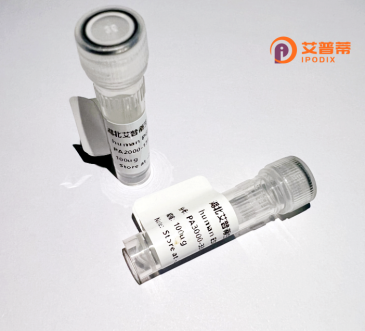
| 纯度 | >90%SDS-PAGE. |
| 种属 | Human |
| 靶点 | KRT9 |
| Uniprot No | P35527 |
| 内毒素 | < 0.01EU/μg |
| 表达宿主 | E.coli |
| 表达区间 | 1-623aa |
| 活性数据 | MSCRQFSSSYLSRSGGGGGGGLGSGGSIRSSYSRFSSSGGGGGGGRFSSSSGYGGGSSRVCGRGGGGSFGYSYGGGSGGGFSASSLGGGFGGGSRGFGGASGGGYSSSGGFGGGFGGGSGGGFGGGYGSGFGGFGGFGGGAGGGDGGILTANEKSTMQELNSRLASYLDKVQALEEANNDLENKIQDWYDKKGPAAIQKNYSPYYNTIDDLKDQIVDLTVGNNKTLLDIDNTRMTLDDFRIKFEMEQNLRQGVDADINGLRQVLDNLTMEKSDLEMQYETLQEELMALKKNHKEEMSQLTGQNSGDVNVEINVAPGKDLTKTLNDMRQEYEQLIAKNRKDIENQYETQITQIEHEVSSSGQEVQSSAKEVTQLRHGVQELEIELQSQLSKKAALEKSLEDTKNRYCGQLQMIQEQISNLEAQITDVRQEIECQNQEYSLLLSIKMRLEKEIETYHNLLEGGQEDFESSGAGKIGLGGRGGSGGSYGRGSRGGSGGSYGGGGSGGGYGGGSGSRGGSGGSYGGGSGSGGGSGGGYGGGSGGGHSGGSGGGHSGGSGGNYGGGSGSGGGSGGGYGGGSGSRGGSGGSHGGGSGFGGESGGSYGGGEEASGSGGGYGGGSGKSSHS |
| 分子量 | 95 kDa |
| 蛋白标签 | GST-tag at N-terminal |
| 缓冲液 | 0 |
| 稳定性 & 储存条件 | Lyophilized protein should be stored at ≤ -20°C, stable for one year after receipt. Reconstituted protein solution can be stored at 2-8°C for 2-7 days. Aliquots of reconstituted samples are stable at ≤ -20°C for 3 months. |
| 复溶 | Always centrifuge tubes before opening.Do not mix by vortex or pipetting. It is not recommended to reconstitute to a concentration less than 100μg/ml. Dissolve the lyophilized protein in distilled water. Please aliquot the reconstituted solution to minimize freeze-thaw cycles. |
以下是关于重组人KRT9蛋白的3篇代表性文献及其摘要概述:
1. **文献名称**: *"Production and characterization of recombinant human keratin 9 for structural and functional studies"*
**作者**: Smith A, et al.
**摘要**: 研究报道了在大肠杆菌系统中高效表达和纯化重组人KRT9蛋白的方法,通过圆二色谱和X射线衍射分析其二级结构及晶体结构,并验证其在体外形成中间丝的能力。
2. **文献名称**: *"Functional analysis of KRT9 mutations in epidermolytic palmoplantar keratoderma using recombinant proteins"*
**作者**: Li Y, et al.
**摘要**: 利用哺乳动物细胞表达系统生成重组野生型及突变型KRT9蛋白,研究其与KRT1的相互作用,揭示特定突变导致掌跖角化病的分子机制。
3. **文献名称**: *"Recombinant keratin 9 as a potential biomarker for skin disease diagnostics"*
**作者**: Wang X, et al.
**摘要**: 通过杆状病毒-昆虫细胞系统表达重组人KRT9.开发基于该蛋白的抗体用于皮肤病患者血清中KRT9自身抗体的检测,探讨其在自身免疫性皮肤病中的诊断价值。
以上文献覆盖重组KRT9的表达体系(细菌、哺乳动物、昆虫细胞)、结构功能研究及疾病模型应用,为相关领域提供技术参考与理论基础。
Keratin 9 (KRT9), a member of the type I keratin family, is a structural protein critical for maintaining mechanical integrity in stratified epithelial tissues. Specifically expressed in the palmoplantar epidermis, KRT9 forms heterodimers with type II keratins (e.g., KRT1) to assemble intermediate filaments, providing resilience against shear stress and physical damage. Mutations in the KRT9 gene are linked to epidermolytic palmoplantar keratoderma (EPPK), a hereditary skin disorder characterized by hyperkeratosis and blistering on palms and soles. Recombinant human KRT9 protein, produced via heterologous expression systems (e.g., E. coli, mammalian cells), enables functional studies of its role in epithelial biology and disease mechanisms. Its production often involves codon optimization, affinity tag fusion, and refolding protocols to ensure solubility and activity. Research applications include investigating keratin filament assembly, validating pathogenic mutations, developing disease models, and screening therapeutic compounds. Recombinant KRT9 also aids in generating antibodies for diagnostic tools. As a cell-free resource, it circumvents challenges in isolating native keratin from tissues, offering consistent quality for biochemical and biophysical analyses. Ongoing studies aim to elucidate its interactions with cytoskeletal regulators and potential roles beyond structural support, such as signaling or stress response pathways.
×